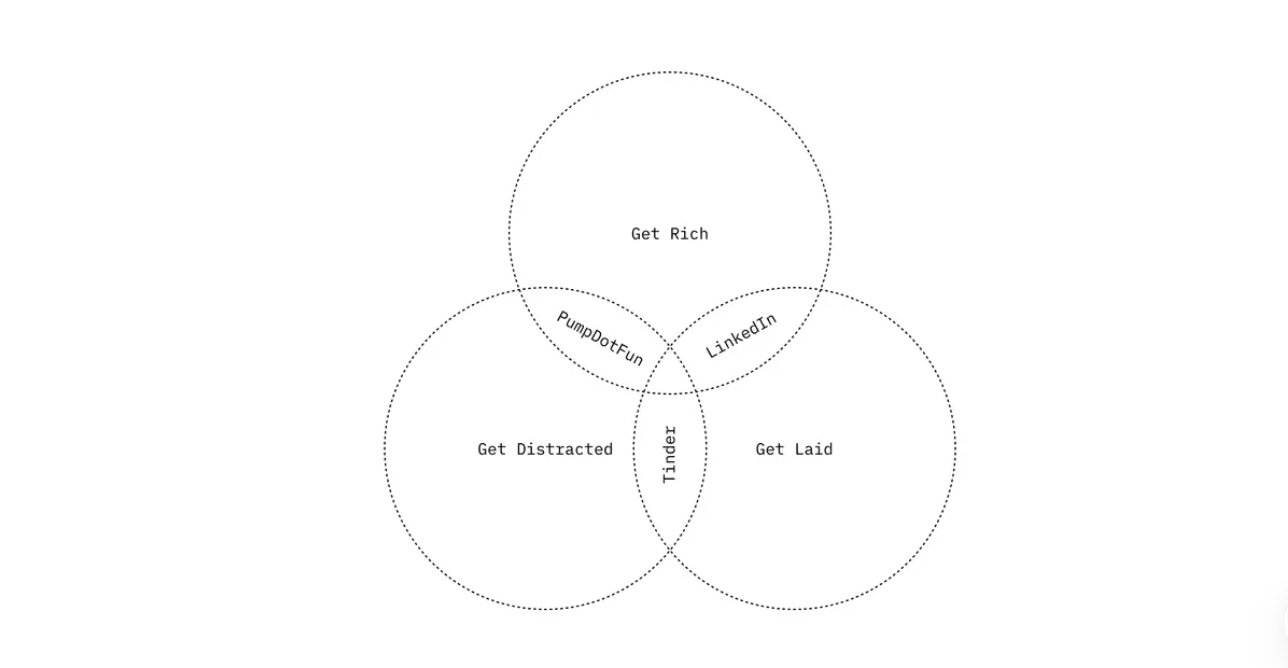視点: 暗号化アプリケーション、テクノロジーについて語るのではなく、ニーズについてもっと語る
原作者:rm
オリジナル編集: Deep Chao TechFlow

消費者向け製品のアプリケーションを作るのは本当に難しいです。現実世界よりも速いトランザクション速度に興奮しているのは、悪名高い早期導入者である私たちだけかもしれません。しかし正直なところ、ユーザーを飽きさせない優れた待機インターフェイスがあれば、速度はそれほど重要ではありません。
本当に重要なことは、ニキータ ビアの言葉を借りれば、ほとんどの消費者向けアプリケーションは、お金持ちになる、社交的、娯楽になるという 3 つのカテゴリと、それらの交差点に分類できるということです。
人々は、お金を稼いだり節約したり、楽しんだり、人々 (同僚、友人、将来の家族など) に出会ったりするために、これらのアプリを使用したいと考えています。これらは、コンシューマ アプリケーションが対象とする基本的なニーズであり、テクノロジそのものではありません。
私たちは何年もの間、「このテクノロジーで何ができるのか? 」と問い続けてきましたが、ほとんどの消費者向けアプリケーションにとってより重要な問題は、人々が何を望んでいるのかということです。テクノロジーはどのようにしてこれらのニーズを新しい方法で満たせるのでしょうか?テクノロジーに基づいた概念化は、非現実的なアイデアにつながることがよくあります。
それでは、ステップ 1: 私たちはどのようなニーズを満たすのでしょうか?それは金持ちになるためでしょうか、社交のためですか、それとも楽しむためですか?そして、そのためにテクノロジーやインフラをどのように活用するのでしょうか?
ユーザーのオンボーディングと維持は、優れたアプリにとって 2 つの重要な瞬間です。ユーザー オンボーディング プロセス中、アプリケーションの機能をデモンストレーションする前に、サービスに接続したり、設定インターフェイスをクリックしたり、フォームに記入したりするようユーザーに求めてはなりません。クリックが増えるたびに、ユーザーはエクスペリエンスを理解する前に道に迷ってしまう可能性があります。ログインを必要とせずに、私のアドレスに基づいてコンテンツを表示することもできます。簡潔かつ迅速に。まず価値を示してから、それに投資してもらいます。
できるだけ早くユーザーと関わり、ポジティブなエクスペリエンスをすぐに提供します。インターフェースとクリック数が増えれば増えるほど、より多くのユーザーを失うことになります。オンボーディングが早く、ユーザーはすぐに「楽しい」と感じることができます。
現在、ユーザーをどのように維持するかが新たな課題となっています。ユーザーは、登録時に期待していたものを得ることができなかった場合、離脱する傾向があります。人々が戻ってくる理由はたくさんありますが、消費者向けアプリの場合、ユーザーが戻ってくるのはコンテンツと関係性がすべてです。チェーン上のすべてのものは巨大なオンライン サービス ゲームのようなものであることを忘れないでください。
既存のプラットフォームからの移行コストが高いため、高品質のコンテンツを取得するのは困難です。 「登録したばかりです。ここに来られてうれしいです」という投稿をたくさん見たくないのです。質の高いコンテンツが必要です。新しいコンテンツ形式は便利ですが、簡単にコピーされ、目新しさを維持するのが最近では困難になっています。
コンテンツへのアクセスが難しい場合、人間関係はさらに重要になります。友人もそこにいるため、人々はプラットフォームに参加することがよくあります。私たちが直面している主な課題は 2 つあります。まず、ユーザー ベースを拡大するには、適切なコミュニティと戦略を構築する必要があります。ニッチな分野から始めることで、製品はより粘着性のあるものになる傾向があります。第二に、暗号通貨によってもたらされた新しいインセンティブ構造により、消費者向けアプリケーションが「投機家」で満たされている場合、金持ちになることを中心とした設計のみが機能します。
ユーザーが社交や娯楽のために来ている場合、疎外感を感じる可能性があります。したがって、最初から適切なコミュニティ向けに設計してください。
アプリを構築するにはどうすればよいですか?
簡単に言えば、あなたのアプリはどのような問題を解決しますか?ユーザーはそれを通じてお金持ちになったり、友達を作ったり、楽しんだりできるでしょうか?複雑なことを何もせずに、すぐに素晴らしい体験を得ることができるでしょうか?コンテンツや他のユーザーが再び戻ってくるように仕向けることができるでしょうか?ユーザー作成のコンテンツとユーザー自身をどのように活用して、新規ユーザーを獲得するように促しますか?
これは従来のオンチェーンの考え方とはまったく異なります。つまり、「契約第一」をあまり重視せず、「需要第一」に重点を置いています。
Web2 で消費者向けアプリケーションを構築するには、多くの場合、アカウント システム、ソーシャル ネットワーク、支払いシステム、データ ストレージを最初から構築する必要があります。ブロックチェーンでは、これらの機能を簡単に利用できます。したがって、テクノロジーに対して想像力を働かせるのではなく、既存のモジュールを使用して新しいものを作成する方法を再考してください。 Farcaster または Lens を使用してソーシャル ネットワークを構築し、ウォレットをアカウントとして使用し、Enso などのオンチェーン操作を使用してトランザクションを完了し、多数のプロトタイプ設計を実行できます。
以前は、オンチェーン テクノロジーは非常に複雑で、複雑なエンジニアリングが必要だったために、自分のアイデアに完全な自信を持っている必要がありました。消費者向けアプリケーションは異なります。まず、ニーズを明確にする必要があります。その後、消費者に適したソリューションが見つかるまで、既存の技術モジュールを使用して迅速に調整できます。消費者製品が 1 つのアイデアから始まることはほとんどなく、継続的なリアルタイムの反復を通じて進化します。
イノベーションはテクノロジーそのものではなく、ユーザーエクスペリエンスに反映されるべきです。既存のモジュールを有効に活用してください。



